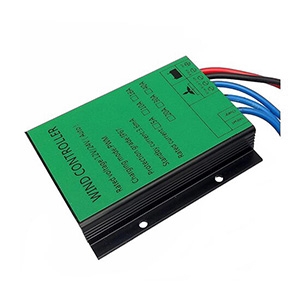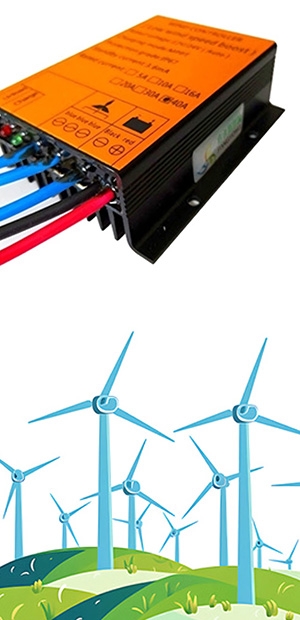Wind power is a vital component of renewable energy, and the wind turbine charge controller is a critical part of any wind power system. It regulates the electricity generated by the wind turbine, ensuring that the energy is safely and stably stored in the batteries while preventing overcharging or discharging. The stable operation of the charge controller directly affects the efficiency and lifespan of the entire wind power system, making regular maintenance and care essential. This blog will delve into the maintenance and care methods for wind turbine charge controllers to help users ensure the long-term reliability of their equipment.
How a Wind Turbine Charge Controller Works?

Before we Home Power Inverter diving into specific maintenance and care methods, it’s important to understand the basic working principle of a wind turbine charge controller. A wind turbine converts wind energy into mechanical energy through the rotation of its blades, and this mechanical energy is then converted into electrical energy by the generator. The charge controller receives the generated electricity and adjusts the charging current based on the battery’s charge state to ensure that the battery is not overcharged or discharged. Charge controllers typically have the following functions:
- Voltage Regulation: Stabilizes the voltage output from the wind turbine within a range acceptable to the batteries.
- Overcharge Protection: Reduces or stops charging when the battery is fully charged to prevent damage.
- Reverse Current Protection: Prevents the battery current from flowing back into the wind turbine, protecting the generator.
- Load Control: Some controllers manage the load by disconnecting non-essential devices when the battery is low to protect its lifespan.
Understanding these functions helps to identify key areas to focus on during maintenance and care.
Routine Maintenance of the Wind Turbine Charge Controller
Routine maintenance is the foundation of ensuring the long-term stable operation of a wind turbine charge controller. Below are some basic steps for daily maintenance:
- Regularly Inspect Connection Cables: Check the cables connecting the wind turbine, controller, and batteries for secure connections, and look for signs of looseness or corrosion. Loose connections can lead to unstable currents, increasing the risk of equipment failure. Ensure that the cables are not physically damaged, such as frayed, broken, or exposed wires. Damaged cables should be replaced promptly to avoid short circuits or other electrical issues.
- Monitor Controller Temperature: The controller generates heat during operation, and excessive temperatures can affect its performance or even damage the equipment. Ensure that the controller is installed in a well-ventilated area and avoid direct sunlight or proximity to other heat sources. Regularly check whether the controller’s heat sinks or fans are functioning properly. If overheating is observed, immediately improve ventilation or replace the cooling components.
- Check the Controller's Status Indicators: Most charge controllers have status indicators or displays showing operational status (e.g., normal operation, overcharge, discharge, fault). Regularly observe these indicators to ensure the controller is functioning correctly. If the indicators show abnormal statuses (e.g., red light stays on or blinks), refer to the device manual or contact a professional for further diagnosis and action.
- Keep the Equipment Clean: Wind power systems are usually installed outdoors, where the controller may be exposed to dust, moisture, and other environmental factors. Regularly clean the controller's exterior, especially the ventilation ports and heat sinks, to prevent dust accumulation that can affect cooling performance. Use a dry, soft cloth for cleaning, and avoid using water or other liquid cleaners to prevent moisture from entering the device.
Periodic Maintenance of the Wind Turbine Charge Controller
In addition to routine maintenance, the wind turbine charge controller requires periodic deep maintenance to ensure the long-term stability of its functions. Here are some periodic maintenance suggestions:
- Comprehensive Electrical Check: Every 3 to 6 months, perform a comprehensive electrical check to test whether the controller’s input and output voltages and currents are normal. Use a multimeter or similar tools to detect electrical parameters, ensuring they are within the device’s specified range. Check the controller’s grounding connection to ensure that the grounding wire is secure and free from corrosion. Poor grounding can cause abnormal operation or even damage the equipment.
- Software and Firmware Updates: Many modern wind turbine charge controllers come with updatable firmware to fix bugs or add new features. If the manufacturer releases firmware updates, it is advisable to update promptly. When updating firmware, ensure that the power supply is stable to avoid power interruptions during the update, which could damage the device or cause data loss.
- Inspection of Lightning Protection Devices: Wind power systems are often exposed to harsh weather conditions, especially during stormy seasons when the charge controller may be at risk of lightning strikes. Therefore, installing lightning protection devices is crucial. Regularly check the working condition of the lightning protection devices to ensure they are in good condition. Replace any damaged or malfunctioning lightning protection devices immediately.
- Battery Management and Maintenance: Although battery maintenance is not directly within the scope of the charge controller, the battery’s condition significantly impacts the controller’s performance. Regularly check the battery’s voltage and capacity to ensure they are within normal ranges. If the battery exhibits signs of decreased capacity or abnormal charging, address the issue promptly or replace the battery to prevent it from affecting the overall system efficiency.
Common Issues and Troubleshooting

During use, the charge controller may encounter some common issues. Understanding these problems and mastering the corresponding troubleshooting methods can effectively reduce downtime and ensure continuous system operation.
1. Overcharging Issue
Symptom: The battery continues to charge beyond a certain voltage, leading to overcharging.
Possible Cause: Faulty voltage detection circuit or calibration error in the controller.
Solution: First, check if the voltage detection circuit in the controller is loose or damaged. If the circuit is normal, it may be necessary to recalibrate the controller’s voltage detection system or replace the controller.
2. Failure to Charge
Symptom: The wind turbine operates normally, but the battery is not charging.
Possible Cause: Faulty rectifier circuit in the controller, loose connection cables, or battery malfunction.
Solution: Check whether the connection between the controller and the battery is secure, and test if the rectifier circuit is functioning properly. If necessary, use replacement parts for testing or replace the faulty battery.
3. Overheating and Automatic Shutdown
Symptom: The wind energy charge controller frequently shuts down automatically in high-temperature environments.
Possible Cause: Poor heat dissipation or overly sensitive temperature protection system.
Solution: Improve ventilation around the controller, and check if the heat sinks or fans are functioning properly. If the temperature protection system is too sensitive, consider adjusting the temperature threshold or replacing the controller.
4. Abnormal Indicator Light Flashing
Symptom: The controller’s status indicator light flashes abnormally.
Possible Cause: Internal system fault, unstable voltage, or interference from external signals.
Solution: Refer to the device manual to identify the fault code, check whether the input voltage is stable, and eliminate external electromagnetic interference.
Tips to Extend the Lifespan of the Wind Turbine Charge Controller
To maximize the lifespan of your wind turbine charge controller, users can take additional preventive measures:
- Choose an Appropriate Installation Location: The controller should be installed in a well-ventilated, dry place away from direct sunlight and rain to reduce the impact of environmental factors on the equipment.
- Regular Professional Inspections: Although routine maintenance and periodic care can prevent most issues, it is still recommended to conduct a comprehensive inspection by a professional technician once a year to ensure all system functions are normal.
- Use High-Quality Accessories: When replacing cables, lightning protectors, and other accessories, choose reliable, high-quality products to avoid damage or safety hazards caused by inferior parts.
The maintenance and care of wind turbine charge controllers are critical to the safe and stable operation of wind power systems. Regular inspections, maintenance, and troubleshooting can significantly extend the controller’s lifespan, improve power generation efficiency, and reduce downtime and economic losses caused by equipment failures. The wind turbine charge controller is specially designed for wind turbine control and battery charging, which can effectively improve the efficiency of wind power generation. If you have purchase intention, please feel free to contact us.
